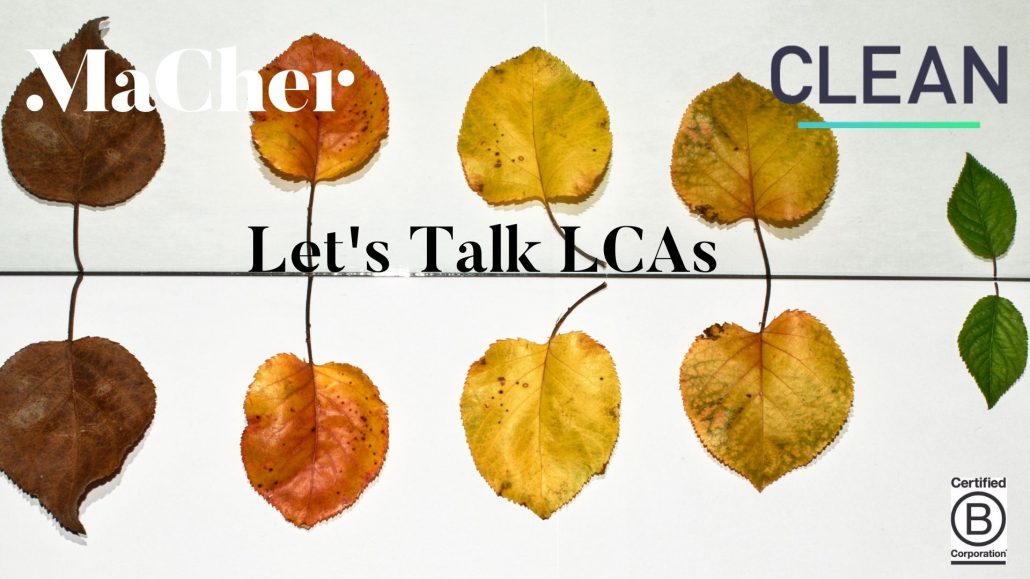How can a company know how much energy, and therefore carbon, it takes to make a product, sell it in a store and then deliver it into a customer’s hands? That is where a Life Cycle Assessment (LCA) comes in say MaCher and Clean Agency.
Everything we buy creates an impact of some kind. Climate changes mean we have stronger forest fires, more intense storms, longer droughts and floods that affect our health. We need all companies to take action.
Some companies offer customers the opportunity to carbon offset the impacts of the products that they buy. The money that customers pay goes to plant trees, mangroves or sea grasses that are great absorbers of carbon, or it is invested in other initiatives that take carbon from the air (see MaCher’s work with SeaTrees as an example).
What is a Lifecycle Assessment?
A Lifecycle Assessment (LCA) helps to measure the environmental impacts associated with all the stages of a product’s life: Material extraction – materials processing – manufacturing – shipping & distribution – use – end of life
The most common impact category assessed by an LCA study measures the carbon footprint. This accounts for the amount of greenhouse gasses emitted during the product’s life cycle (reported as CO2eq). Impact categories defined by defined LCA methods can also take into consideration the water impact, biodiversity impact and social impact.
- Stage 1: The first stage in LCA modeling is to define the goal and scope of the study. This includes the system boundary or what’s included as part of the assessment and what has been left out. It’s important to state boundaries so that there is transparency over what is being measured and what can be controlled.
- Stage 2: Inventory analysis addresses the materials and processes within the product system. It’s common for LCA’s to make assumptions when accurate data isn’t available. Measuring can be hard. It can be difficult to find out how much waste, water or energy is used in making a product. However, the more that LCA’s are used and the more that data is collected and then measured and shared, the more accurate they can become. Assumptions are also important to share to improve transparency on what is included in the footprint measurement.
- Stages 3 & 4: Impact assessment and interpretation are also considered as stage number 3 & 4 of the LCA analysis under the ISO 14040 guidelines.
Why do an LCA?
We use lifecycle assessments to understand the impact of creating our products and what we can change to improve. By analyzing our calculations, we are able to understand how to improve efficiencies. LCA would help find hotspots, so further actions may be taken to mitigate the impacts accordingly. We can also look at opportunities to decarbonise. Can we use different materials or transport or work with our factories to install renewable energy, for example?
Our LCA calculations also help us quantify the amount of carbon credits we need to buy to compensate for carbon emissions. Last, it would help us find the right direction and priorities through our strategic planning.
LCAs and their boundaries for MaCher
MaCher’s LCA accounts for the impact of raw material production, manufacturing methods, packaging and shipping to our customer.
After our products are delivered to our customer’s warehouse and beyond to customers, we lose visibility of them. This is where assumptions come in.
We have assumed our products don’t require a lot of energy as they aren’t washed regularly or require energy to function. We don’t know how our end consumers will dispose of the product and at the moment, our data isn’t able to capture the breakdown emissions of our products. Instead, we aim to use materials that can be reintroduced to the supply chain or those that have a greater chance of degrading without causing harm. We can also use messaging to reach consumers and help them understand how best to dispose of a product.
LCA scoring
After entering the data we have on emissions at all of the different stages of the product lifecycle, the LCA calculator gives us a resulting score.
That depends on the scope of the LCA. We need to try measure the full lifecycle or the full impact but it is difficult if accurate data is missing. LCA reports are defined based on internationally accepted standards and are widely used to quantify environmental burdens following similar databases and methods. So the results may allow parties involved to compare two products based on their functional units.
Once you know the score you can compare different brands or retailers, identify opportunities for continuous sustainability improvement or find the challenges during with full consideration to the environmental impacts made by the product in its entire life cycle.
Where can I get an LCA?
Accurate LCA’s should be built in collaboration with experts. We partnered with Clean Agency who provided the data and defined the scope that suited our needs. They have also built LCA calculators for other B Corps like Allbirdsand Reformation.
We would love to show you some examples of how using an LCA has helped companies choose more efficient products. Please contact MaCher.
If you are interested in conducting your own LCA, Clean Agency, please contact them here.


